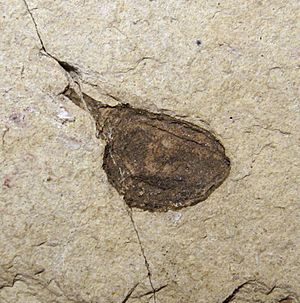Eucommia montana facts for kids
Quick facts for kids Eucommia montana |
|
|---|---|
 |
|
| E. montana, Washington state | |
| Scientific classification | |
| Genus: |
Eucommia
|
| Species: |
montana
|
| Synonyms | |
|
|
Eucommia montana was an extinct type of flowering plant. It belonged to the plant family called Eucommiaceae. We know about E. montana because scientists have found its fossil fruits. These fossils were discovered in rocks from the Eocene period.
These ancient fruits have been found in many places across North America. This includes the northwestern United States, like Oregon, Montana, and Colorado. They have also been found in southeastern British Columbia, Canada. E. montana is one of five fossil species from North America that are part of the modern plant group Eucommia. Other related fossil species include E. constans, E. eocenica, E. jeffersonensis, and E. rowlandii.
Contents
Discovering Eucommia montana
Scientists first officially described Eucommia montana in 1940. A scientist named Roland W. Brown was the first to study and name it. He found its fossils in the Renova Formation, a rock layer near Grant in Beaverhead County, Montana. These fossils came from the late Eocene period.
More Discoveries and Changes
Later, in 1960, another scientist, Herman F. Becker, found more fossils. These were in the Ruby River Basin of southwestern Montana. He thought they were a new species because they seemed smaller. He named them Eucommia brownii.
However, as more fossils were found in the 1960s, scientists saw a wider range of sizes. This showed that the smaller fruits were just part of the normal size range for E. montana. So, in 1969, Becker decided that E. brownii was actually the same species as E. montana.
Expanding the Story of E. montana
In 1997, two paleobotanists, Victor B. Call and David L. Dilcher, looked at the fossils again. They were from the University of Florida. Their research helped us understand much more about E. montana.
They found that this plant lived over a much larger area and for a longer time than first thought. They identified E. montana fossils from many new places across western North America.
- Oldest Finds: The oldest E. montana fossils are from the Early Eocene. They were found in the Klondike Mountain Formation in northern Washington state.
- Southern Reach: Fossils from the Green River Formation in Rainbow, Utah, and near Douglas Pass, Colorado, showed the plant lived further south.
- Northern Reach: Fossils from Quilchena, British Columbia, Canada, extended its known range to the north. Another Eucommia species, E. rowlandii, was also found there.
- Southwestern Reach: Fossils from the Clarno Formation and John Day Formation in Central Oregon showed it lived further southwest.
- Youngest Finds: Some of the most recent fossils of E. montana are from the Late Eocene Florissant Formation in Colorado.
All these new fossils, from Washington to Colorado, fit within the size and shape variations seen in the original Montana fossils. This helped scientists confirm they were all E. montana.
What Eucommia montana Looked Like
The fruits of E. montana were not perfectly even; they were asymmetrical. Each fruit had two flattened parts called nutlets. These nutlets were surrounded by narrow, wing-like structures.
Fruit Details
- Shape: The tips of the fruits were usually rounded. They had a small opening called a stigmatic cleft that was slightly off-center because of the fruit's uneven shape.
- Size: These fruits varied in length from about 5.2 to 11.4 millimeters (about 0.2 to 0.45 inches). The average length was about 8.65 millimeters (about 0.34 inches). Their width ranged from 3.2 to 6.8 millimeters (about 0.13 to 0.27 inches).
- Structure: Each E. montana fruit had one fully developed carpel. The second carpel was much smaller, appearing as a narrow strip of tissue. It was usually just over half the length of the main carpel.
Special Clues
Scientists found preserved, sticky latex threads on some fossils from Quilchena and the Klondike Mountain Formation. The presence of these latex threads was a strong clue. It helped confirm that these ancient seeds definitely belonged to the Eucommia group of plants.

